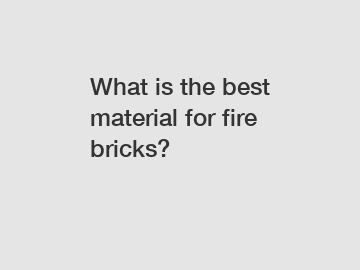What is the best material for fire bricks?
What is the best material for fire bricks?
Fire bricks are a critical component when it comes to constructing fireplaces, wood-fired ovens, and other high-temperature applications. They are specially designed to withstand extreme heat and provide insulation to prevent the heat from escaping. However, choosing the right material for fire bricks can be challenging, as there are several options available in the market. In this article, we will explore some of the best materials for fire bricks, highlighting their advantages and disadvantages.
1. Clay Bricks.

Clay bricks are the most traditional and commonly used type of fire bricks. They are made from clay and minerals, which are fired at high temperatures to achieve their desired strength. Clay bricks offer excellent thermal resistance and insulation properties, making them ideal for applications where high temperatures are involved. Moreover, they are cost-effective and readily available. However, clay bricks can be brittle and prone to cracks if exposed to rapid temperature changes. Additionally, they are not suitable for extremely high temperatures.
2. High Alumina Bricks.
High alumina bricks are made from a mixture of bauxite and other raw materials containing high levels of alumina. These bricks can withstand significantly higher temperatures compared to clay bricks, making them suitable for applications that involve intense heat, such as industrial furnaces and kilns. High alumina bricks also have excellent resistance to thermal shock and chemical corrosion. However, they are more expensive than clay bricks and may not be easily accessible in all locations.
3. Silica Bricks.
Silica bricks are made from raw materials rich in silica, such as quartzite or ganister. They are known for their superior thermal insulation and high thermal shock resistance. Silica bricks are commonly used in glass manufacturing, steelmaking, and other industries where high temperatures and rapid cooling are involved. They can withstand temperatures up to 1700°C (3092°F). However, silica bricks can be more expensive than clay bricks and are not as widely available.
4. Magnesia Bricks.
Magnesia bricks are made from magnesium oxide (MgO) and are renowned for their excellent resistance to high temperatures and chemical corrosion. They can withstand temperatures ranging from 1500°C to 2000°C (2732°F to 3632°F) and are commonly used in industries such as steelmaking, cement production, and non-ferrous metal smelting. However, magnesia bricks can be vulnerable to hydration, which can lead to cracking. They are also relatively expensive compared to other fire brick materials.
5. Calcium Silicate Bricks.
Calcium silicate bricks are mainly composed of lime and silica. They offer excellent thermal insulation and are commonly used in industrial applications, such as petrochemical plants and power stations. Calcium silicate bricks can withstand temperatures up to 1000°C (1832°F) and are resistant to thermal shock. However, they are not suitable for applications involving extremely high temperatures.
In conclusion, choosing the best material for fire bricks depends on the specific requirements of the application. Clay bricks are a cost-effective option for moderate heat environments, while high alumina bricks and silica bricks are suitable for higher temperatures. Magnesia bricks are ideal for extreme heat conditions, but they may be more expensive. Calcium silicate bricks provide excellent insulation but are not suitable for extremely high temperatures. Ultimately, it is essential to consider factors such as cost, availability, heat resistance, and application requirements when selecting fire brick materials.
If you have any further questions or need assistance with fire bricks, please feel free to contact us.
Contact us to discuss your requirements of refractory mortar, industrial furnaces refractory bricks, ceramic fibre blanket dealer. Our experienced sales team can help you identify the options that best suit your needs.
201
0
0

Comments
All Comments (0)